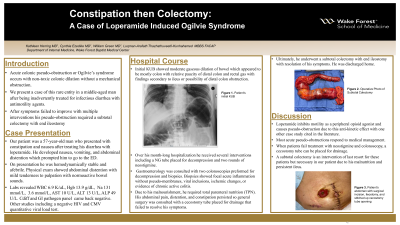Back


Poster Session B - Monday Morning
Category: Colon
B0156 - Constipation Then Colectomy: A Case of Loperamide-Induced Ogilvie Syndrome
Monday, October 24, 2022
10:00 AM – 12:00 PM ET
Location: Crown Ballroom

Has Audio
- CE
Cynthia Ezedike, MD
Wake Forest Baptist Health
Winston-Salem, NC
Presenting Author(s)
Kathleen Herring, MD1, Cynthia Ezedike, MD2, William C. Green, MD3, Luqman-Arafath Thazhathuveetil-Kunhahamed, MBBS2
1Internal Medicine Residency Program, Wake Forest University School of Medicine, Winston-Salem, NC; 2Wake Forest Baptist Health, Winston-Salem, NC; 3Wake Forest University School of Medicine, Winston-Salem, NC
Introduction: Acute colonic pseudo-obstruction or Ogilvie syndrome occurs with colonic dilatation without a mechanical obstruction. We present a case of this rare entity in a middle-aged man after being inadvertently treated for infectious diarrhea with antimotility agents. After symptoms failed to improve with multiple interventions including neostigmine and endoscopic decompression, his pseudo-obstruction required a subtotal colectomy with end ileostomy.
Case Description/Methods: Our patient was a 57-year-old man who presented with abdominal pain, constipation, and nausea after treating his diarrhea with loperamide. On presentation he was hemodynamically stable and afebrile. Physical exam showed abdominal distention with mild tenderness to palpation with normoactive bowel sounds. His WBC was 6.9K/uL, Hgb 13.9 g/dL, sodium 131 mmol/L, and potassium 3.6 mmol/L. His Clostridioides difficile antigen and GI pathogen panel came back negative. Other studies included a negative HIV and CMV quantitative viral load test. Initial KUB showed moderate gaseous dilation of the bowel which appeared to be mostly colon with findings secondary to ileus or possible distal colon obstruction. Over his month long hospitalization he received several interventions including a nasogastric tube for decompression and two rounds of neostigmine. Gastroenterology was consulted with two colonoscopies preformed for decompression and biopsies. Biopsies showed focal acute inflammation without psuedo-membranes, viral inclusions, ischemic changes, or evidence of chronic active colitis. Due to his malnourishment he required total parenteral nutrition. His abdominal pain, distention, and constipation persisted so general surgery was consulted who placed a cecostomy tube for drainage that failed to resolve his symptoms. Ultimately he underwent a subtotal colectomy with end ileostomy with resolution of his distention and discharged home.
Discussion: Loperamide inhibits colonic motility as a peripheral opioid agonist. This anti-kinetic effect is the proposed mechanisms of this man's pseudo-obstruction. Most acute pseudo-obstructions respond to medical management with neostigmine. When patients fail treatment with neostigmine and colonoscopy, a cecostomy tube can be placed for drainage. A subtotal colectomy is an intervention of last resort for these patients but necessary in our patient due to his malnutrition that required TPN and persistent ileus.

Disclosures:
Kathleen Herring, MD1, Cynthia Ezedike, MD2, William C. Green, MD3, Luqman-Arafath Thazhathuveetil-Kunhahamed, MBBS2. B0156 - Constipation Then Colectomy: A Case of Loperamide-Induced Ogilvie Syndrome, ACG 2022 Annual Scientific Meeting Abstracts. Charlotte, NC: American College of Gastroenterology.
1Internal Medicine Residency Program, Wake Forest University School of Medicine, Winston-Salem, NC; 2Wake Forest Baptist Health, Winston-Salem, NC; 3Wake Forest University School of Medicine, Winston-Salem, NC
Introduction: Acute colonic pseudo-obstruction or Ogilvie syndrome occurs with colonic dilatation without a mechanical obstruction. We present a case of this rare entity in a middle-aged man after being inadvertently treated for infectious diarrhea with antimotility agents. After symptoms failed to improve with multiple interventions including neostigmine and endoscopic decompression, his pseudo-obstruction required a subtotal colectomy with end ileostomy.
Case Description/Methods: Our patient was a 57-year-old man who presented with abdominal pain, constipation, and nausea after treating his diarrhea with loperamide. On presentation he was hemodynamically stable and afebrile. Physical exam showed abdominal distention with mild tenderness to palpation with normoactive bowel sounds. His WBC was 6.9K/uL, Hgb 13.9 g/dL, sodium 131 mmol/L, and potassium 3.6 mmol/L. His Clostridioides difficile antigen and GI pathogen panel came back negative. Other studies included a negative HIV and CMV quantitative viral load test. Initial KUB showed moderate gaseous dilation of the bowel which appeared to be mostly colon with findings secondary to ileus or possible distal colon obstruction. Over his month long hospitalization he received several interventions including a nasogastric tube for decompression and two rounds of neostigmine. Gastroenterology was consulted with two colonoscopies preformed for decompression and biopsies. Biopsies showed focal acute inflammation without psuedo-membranes, viral inclusions, ischemic changes, or evidence of chronic active colitis. Due to his malnourishment he required total parenteral nutrition. His abdominal pain, distention, and constipation persisted so general surgery was consulted who placed a cecostomy tube for drainage that failed to resolve his symptoms. Ultimately he underwent a subtotal colectomy with end ileostomy with resolution of his distention and discharged home.
Discussion: Loperamide inhibits colonic motility as a peripheral opioid agonist. This anti-kinetic effect is the proposed mechanisms of this man's pseudo-obstruction. Most acute pseudo-obstructions respond to medical management with neostigmine. When patients fail treatment with neostigmine and colonoscopy, a cecostomy tube can be placed for drainage. A subtotal colectomy is an intervention of last resort for these patients but necessary in our patient due to his malnutrition that required TPN and persistent ileus.

Figure: A. Patient's initial KUB
B. Operative photo of subtotal colectomy
C. Patient's abdomen with surgical incision, ileostomy, and stitched up cecostomy tube opening
B. Operative photo of subtotal colectomy
C. Patient's abdomen with surgical incision, ileostomy, and stitched up cecostomy tube opening
Disclosures:
Kathleen Herring indicated no relevant financial relationships.
Cynthia Ezedike indicated no relevant financial relationships.
William Green indicated no relevant financial relationships.
Luqman-Arafath Thazhathuveetil-Kunhahamed indicated no relevant financial relationships.
Kathleen Herring, MD1, Cynthia Ezedike, MD2, William C. Green, MD3, Luqman-Arafath Thazhathuveetil-Kunhahamed, MBBS2. B0156 - Constipation Then Colectomy: A Case of Loperamide-Induced Ogilvie Syndrome, ACG 2022 Annual Scientific Meeting Abstracts. Charlotte, NC: American College of Gastroenterology.
